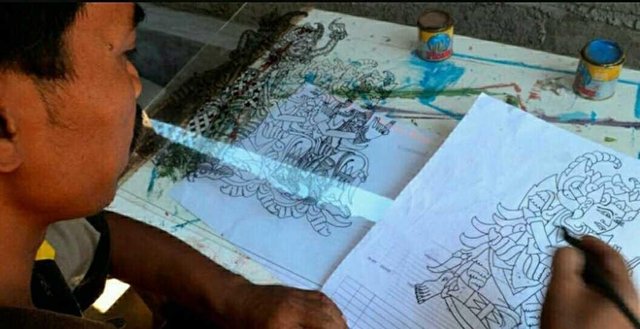The history of glass painting
Hello steemit friends met back with me @sahriyal.
on this occasion I shared some photos and information about glass painting.
 )
)
Glass painting today may not be the art of great public interest. But by the end of the eighteenth to the nineteenth centuries it was a popular work of art.
Not only owned by the rich and the nobles only, most people have many.
The director of the Center for Southeast Asian Studies in France (CNRS-EHES-INALCO) explained that in the 18-20th century, it was estimated that the number reached millions of pieces assumed from the current population of Dutch census data. This glass painting was introduced by European and Chinese painters. In the archipelago then developed with the pattern and local themes and cultural mixing such as Java, Europe, China and Muslims. They display the painting as a status symbol, reject the reinforcements and decorations.
 )
)
The earliest data on this glass painting was obtained from the German explorer logbook that wrote about Sultan Sumenep who had a hobby of painting glass in 1850. The first study was conducted by Hooykas-van Leeuwen Boomkamp, in 1930 describing the situation of glass painting in Yogyakarta at that time. The next data is widely described by Japanese researchers led by Seichi Sasaki in 1980.
Then proceed from Eddy Hadi Waluyo's research on the revitalization of glass painting in Yogyakarta, Solo, Cirebon and Buleleng Bali for the period of 1980-2000. More than 90 percent of the data collected, he said, the work is undated and anonymous.
 )
)
 )
)
Themes encountered ranging from the themes of paintings of mosques, wayang, images of reinforcements, Dutch history (such as images of the murder of Captain Tack and Untung Suropati banned and traded by the Dutch), Javanese culture, court drawings, bridal paintings, slapsticks, Princess Campa), Chinese calligraphy.
This glass painting in Java is centered in Solo, Yogyakarta and Cirebon. Outside Java, said Samuel, also found in Bali. There are also glass paintings in Minang and Bengkulu. Most of the themes are local tales, calligraphy, mosques and flowers.
He called the period of the 1940s an important point of glass painting is because there is a fundamental theme in the era of Japanese occupation and post-independence. He cited the theme of mosque painting in the popular 1918s picture of the Demak mosque, but post-independence popular is the mosque of the Martyrs.

In the 1960s there were still many paintings of puppets, masjas and brides found in the homes of ordinary citizens. In the 1970s, this work also achieved its post-independence glory and slowly dimmed again. Until then the Regional Government of Cirebon re-promote this painting as an effort of revitalization and regional icons.
 )
)
 )
)
so that's a bit of information from me about glass painting hopefully steemit friends love it.
Best regards from me @sahriya.
Congratulations! This post has been upvoted from the communal account, @minnowsupport, by sahriyal from the Minnow Support Project. It's a witness project run by aggroed, ausbitbank, teamsteem, theprophet0, someguy123, neoxian, followbtcnews, and netuoso. The goal is to help Steemit grow by supporting Minnows. Please find us at the Peace, Abundance, and Liberty Network (PALnet) Discord Channel. It's a completely public and open space to all members of the Steemit community who voluntarily choose to be there.
If you would like to delegate to the Minnow Support Project you can do so by clicking on the following links: 50SP, 100SP, 250SP, 500SP, 1000SP, 5000SP.
Be sure to leave at least 50SP undelegated on your account.